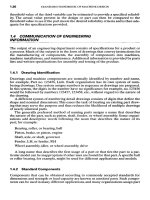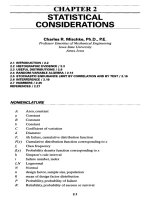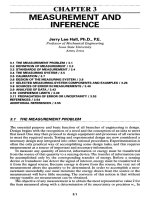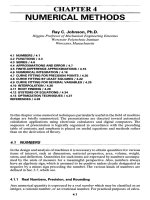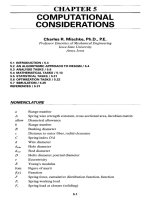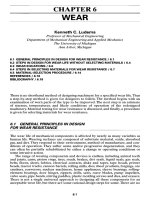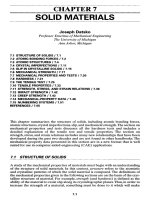Sổ tay tiêu chuẩn thiết kế máy P11 potx
Bạn đang xem bản rút gọn của tài liệu. Xem và tải ngay bản đầy đủ của tài liệu tại đây (1.12 MB, 34 trang )
CHAPTER
8
THE
STRENGTH
OF
COLD-WORKED
AND
HEAT-TREATED
STEELS
Charles
R.
Mischke, Ph.D.,
RE.
Professor
Emeritus
of
Mechanical
Engineering
Iowa
State
University
Ames,
Iowa
8.1
INTRODUCTION
/
8.2
8.2
STRENGTH
OF
PLASTICALLY DEFORMED MATERIALS
/ 8.3
8.3
ESTIMATING ULTIMATE STRENGTH AFTER PLASTIC STRAINS
/ 8.4
8.4
ESTIMATING YIELD STRENGTH AFTER PLASTIC STRAINS
/ 8.8
8.5
ESTIMATING ULTIMATE STRENGTH
OF
HEAT-TREATED
PLAIN CARBON STEELS
/ 8.9
8.6
ESTIMATING ULTIMATE STRENGTH
OF
HEAT-TREATED
LOW-ALLOY
STEELS
/
8.11
8.7
TEMPERING
TIME
AND
TEMPERATURE TRADEOFF RELATION
/
8.29
8.8
COMPUTER PROGRAMS
/
8.29
REFERENCES
/
8.34
RECOMMENDED READING
/
8.34
GLOSSARY
AR
Fractional area reduction
A
Area
B
Critical hardness
for
carbon content
and
tempering temperature,
Rockwell
C
scale
d
Diameter
D
Tempering decrement, Rockwell
C
scale; carbon ideal diameter,
in
DI
Ideal critical diameter,
in
DH
Distant hardness, Rockwell
C
scale
EJD
Equivalent Jominy distance, sixteenths
of
inch
/
Tempering
factor
for
carbon content
and
tempering temperature
F
Load,
temperature,
degrees
Fahrenheit
H
Quench severity,
in"
1
IH
Initial hardness, Rockwell
C
scale
m
Strain-strengthening exponent
n
Design factor
r
Radius
^max
Maximum hardness attainable, Rockwell
C
scale
RQ
As-quenched Jominy test hardness, Rockwell
C
scale
R
T
Tempered hardness, Rockwell
C
scale
S'
e
Engineering endurance limit
S
u
Engineering ultimate strength
in
tension
S
y
Engineering yield strength,
0.2
percent
offset
t
Time
8
True strain
r|
Factor
of
safety
(T
0
Strain-strengthening
coefficient
a
Normal stress
IA Sum of
alloy increments, Rockwell
C
scale
I
0
Octahedral shear stress
T
Shearing stress
Subscripts
a
Axial
B
Long traverse
c
Compression
C
Circumferential
D
Short traverse
e
Endurance
/
Fracture
L
Longitudinal
R
Radial
s
Shear
t
Tension
u
Ultimate
y
Yield
O
No
prior strain
8.1
INTRODUCTION
The
mechanical designer needs
to
know
the
yield strength
of a
material
so
that
a
suitable
margin against permanent distortion
can be
provided.
The
yield strength
provided
by a
standardized tensile test
is
often
not
helpful
because
the
manufactur-
ing
process
has
altered this property.
Hot or
cold
forming
and
heat treatment
(quenching
and
tempering) change
the
yield strength.
The
designer needs
to
know
the
yield strength
of the
material
at the
critical location
in the
geometry
and at
con-
dition
of
use.
The
designer also needs knowledge
of the
ultimate strength, principally
as an
estimator
of
fatigue
strength,
so
that
a
suitable margin against fracture
or
fatigue
can
be
provided.
Hot and
cold
forming
and
various thermomechanical treatments dur-
ing
manufacture have altered these properties too. These changes vary within
the
part
and can be
directional. Again,
the
designer
needs
strength information
for the
material
at the
critical location
in the
geometry
and at
condition
of
use.
This chapter addresses
the
effect
of
plastic strain
or a
sequence
of
plastic strains
on
changes
in
yield
and
ultimate strengths (and associated endurance limits)
and
gives
quantitative methods
for the
estimation
of
these properties.
It
also examines
the
changes
in
ultimate strength
in
heat-treated plain carbon
and
low-alloy steels.
8.2
STRENGTHOFPLASTICALLY
DEFORMED MATERIALS
Methods
for
strength estimation include
the
conventional uniaxial tension test,
which
routinely measures true
and
engineering yield
and
ultimate strengths, per-
centage elongation
and
reduction
in
area, true ultimate
and
fracture
strains, strain-
strengthening exponent, strain-strengthening
coefficient,
and
Young's modulus.
These
results
are for the
material
in
specimen
form.
Machine parts
are of
different
shape, size, texture, material treatment,
and
manufacturing history
and
resist loading
differently.
Hardness tests
can be
made
on a
prototype part,
and
from
correlations
of
strength with hardness
and
indentor size
([8.1],
p.
5-35)
and
surface, ultimate
strength
can be
assessed. Such information
can be
found
in
corporate manuals
and
catalogs
or
scattered
in the
literature.
Often
these
are not
helpful.
In the
case
of a
single plastic deformation
in the
manufacturing
process,
one can
use
the
true stress-strain curve
of the
material
in the
condition prior
to
straining pro-
vided
the
plastic strain
can be
determined.
The
results
are
good.
For a
sequence
of
successive
strains,
an
empirical method
is
available which approximates what hap-
pens
but is
sometimes
at
variance with test results.
Cold
work
or
strain
strengthening
is a
common result
of a
cold-forming process.
The
process changes
the
properties,
and
such changes must
be
incorporated into
the
application
of a
theory
of
failure.
The
important strength
is
that
of the
part
in the
critical location
in the
geometry
and at
condition
of
use.
8.2.1
Datsko's
Notation
In any
discussion
of
strength
it is
necessary
to
identify
1. The
kind
of
strength: ultimate,
u;
yield,y;
fracture,/-
endurance,
e.
2. The
sense
of the
strength:
tensile,
t;
compressive,
c;
shear,
s.
3. The
direction
or
orientation
of the
strength: longitudinal,
L;
long transverse,
B;
short transverse,
D;
axial,
a;
radial,
R;
circumferential,
C
4. The
sense
of the
most recent prior strain
in the
axial direction
of the
envisioned
test specimen: tension,
t;
compression,
c. If
there
is no
prior strain,
the
subscript
O
is
used.
8.2.2
Datsko's
Rules
Datsko
[8.1] suggests
a
notation
(51)234,
where
the
subscripts correspond
to
1,2,
3,
and
4
above.
In
Fig.
8.1 an
axially
deformed round
and a
rolled plate
are
depicted.
A
strength
(Su)
tLc
would
be
read
as the
engineering ultimate strength
S
u
,
in
tension
(£„)„
in the
longitudinal direction
(S
u
)
tL
,
after
a
last prior strain
in the
specimen
direction that
was
compressive
(S
u
)
tLc
.
Datsko [8.1]
has
articulated rules
for
strain
strengthening that
are in
approximate agreement
with
data
he has
collected.
Briefly,
Rule
L
Strain strengthening
is a
bulk mechanism, exhibiting changes
in
strength
in
directions
free
of
strain.
Rule
2. The
maximum strain that
can be
imposed lies between
the
true strain
at
ultimate load
e
u
and the
true
fracture
strain
e/.
In
upsetting procedures devoid
of
flexure,
the
limit
is
e/,
as
determined
in the
tension test.
Rule
3. The
significant
strain
in a
deformation cycle
is the
largest absolute strain,
denoted
e
w
.
In a
round
e
w
=
max(le
r
l,
Ie
9
I,
Ie
x
I).The
largest absolute strain
£„
is
used
in
calculating
the
equivalent plastic strain
e
g
,
which
is
defined
for two
categories
of
strength, ultimate
and
yield,
and in
four
groups
of
strength
in
Table 8.1.
Rule
4. In the
case
of
several strains applied sequentially (say, cold rolling then
upsetting),
in
determining
e
gM
,
the
significant
strains
in
each cycle
e
w/
are
added
in
decreasing order
of
magnitude rather than
in
chronological order.
Rule
5. If the
plastic strain
is
imposed below
the
material's recrystallization tem-
perature,
the
ultimate tensile strength
is
given
by
S
u
=
(Su)
0
exp
z
qu
z
qu
< m
=
Go(z
q
uY
z
qu
>m
Rule
6. The
yield strength
of a
material whose recrystallization temperature
was
not
exceeded
is
given
by
S
y
=
G
0
(e
qy
)
m
Table
8.1
summarizes
the
strength relations
for
plastically deformed metals.
8.3
ESTIMATINGULTIMATESTRENGTH
AFTER
PLASTIC STRAINS
This topic
is
best illuminated
by
example, applying ideas expressed
in
Sees.
8.2.1
and
8.2.2.
Example
1. A
1045HR
bar has the
following
properties
from
tension tests:
Sy
= 60
kpsi
S
u
=
92.5 kpsi
AR =
0.44
m =
0.14
The
material
is to be
used
to
form
an
integral pinion
on a
shaft
by
cold working
from
2
1
/
in to 2 in
diameter
and
then upsetting
to
2
1
A
in to
form
a
pinion blank,
as
depicted
in
Fig. 8.2. Find, using
Datsko's
rules,
an
estimate
of the
ultimate strength
in a
direc-
tion resisting
tooth
bending
at the
root
of the
gear tooth
to be cut in the
blank.
FIGURE
8.1
Sense
of
strengths
in bar and
plate.
(Adapted
from
[8.1],
p. 7-7
with
permission.)
(a)
Original
bar
before axial deformation.
Specimen Sense
of
strength Direction
in the bar
Prior strain Designation
(b)
1 t L c
(S)
tL
2
c
Lc
(S)
cL
3
t
Tt
(S)
tT
4
c
Tt
(S)
cT
(c)
5 t L t
(S)
tL
6
c
Lt
(S)
CL
It
Tc
(S\
T
8 c
T
c
(S)
cT
(d)
Plate prior
to
rolling.
Specimen Sense
of
strength Direction
in the bar
Prior strain Designation
(e)
1 t L t
(S)
tLt
2
c
Lt
(S)
cLt
3
t
Dc
(S)
tDc
4
c
Dc
(S)
cDc
5
t
BQ
(S)
180
6
c
B O
(S)
cBO
TABLE
8.1
Strength Relations
for
Plastically
Deformed
Metals
f
Cs
v
)
w
-
"oW"
,„.
_
{
(S
u
)o
exp
e^
e
?M
<
m
™»
- I
?„
C
01
> m
Strength
Group designation
e^
M
e
w
(SW
(ft
* £*
« 7rfe-
(SU
'-'
'
*
+
0
-
2e
««
(SW
2
(SW
e
.y***
E
.
e
*«
2
(SW
e<
"
fct
/
"
1
+
0.Se
1-1
(
<
S
*l
cU
r
-V
c
-
e^
3
(O
)/Lr
e
<7«0
-
2_-
y
,
i
e
«*
~
,
,
7p
(SW
i-l'+
1
1^26,,O
4
(
5
)^
e
^
=
y^_£±L-
f
4
(sw
e
^
£r/+i
*
t
Plastic
deformation
below
material's
recrystallization
temperature.
t
(S
y
),rr
-
(^)rr/
=
0.95(S^
77
or
Q.9S(S
y
)
cT
c
£qus
-
equivalent
strain
when prestrain
sense
is
same
as
sense
of
strength
c
quo
-
equivalent strain when
prestrain
sense
is
opposite
to
sense
of
strength
SOURCE:
From Datsko [8.1]
and
Hertzberg
[8.2].
The
strain-strengthening
coefficient
a
0
is,
after
[8.3],
G
0
-
S
11
exp
(m)nr
m
=
92.5
exp
(0.14)0.14-°
14
-
140.1 kpsi
The
fracture
strain (true)
of the
hot-rolled material
from
the
tension test
is
£
f
=
ln
T^AR
=ln
1^044
=0
'
58
which
represents limiting strain
in
deformation
free
of
bending (rule
2). In the
first
step (cold rolling),
the
largest strain
is
axial,
and it has a
magnitude
of
(rule
3)
-"(Ii)'
^PfJ=O-
In the
second step (upsetting),
the
largest strain
is
axial,
and it has a
magnitude
(rule
3) of
E
2
=
mf^)
-
In
(-^Vf
-l-0.446l-0.446
\D
2
)
\2.5/
FIGURE
8.2
Cold
working
bar
stock
in two
steps
to
form
integral
pinion
blank
on
spindle.
The
significant
strains
e
wl
and
z
w2
are
(rule
4)
e
wl
=
0.446
and
z
w2
=
0.236. Strengths
will
be
carried with four computational digits until numerical work
is
done.
For
group
1
strengths,
v
z
wi
0.446
0.236
_
^
=
Z-T
=
~T~
+
~~2~
=
a564
S
u
=
o
Q
(z
qu
)
m
=
140.1(0.564)°-
14
=
129.3 kpsi
According
to
rule
5,
£
qu
> m.
For
group
2
strengths,
^
e
wi
-
0.446 0.236
n
e
,
<^=Z-f=—+—=o.564
S
u
=
a
0
(£,
H
)
m
-140.1(0.564)°
14
=
129.3
kpsi
For
group
3
strengths,
^
e
wi
-
0.446
0.236
n
^
M
^=ST77 2"
+
-r-
=a302
S
u
=
a
0
(e
qu
)
m
=
140.1(0.302)°
14
=
118.5
kpsi
For
group
4
strengths,
_
y
_e^_
0446
0236
8
^-Z
1
+
/-
23
"
JUZ
S
u
=
a
0
(B,
M
)
m
=
140.1(0.302)°-
14
=
118.5
kpsi
The
endurance limit
and the
ultimate strength resisting tensile bending stresses
are
(S
e
')
m
and
(S
M
)m,
namely,
129.3/2
=
64.7 kpsi
and
129.3 kpsi, respectively (group
2
strengths).
The
endurance limit
and the
ultimate strength resisting compressive
bending stresses
are
(S'
e
)
cTt
and
(S
u
)
cTt
,
namely,
118.5/2
=
59.3 kpsi
and
118.5 kpsi,
respectively (group
4
strengths).
In
fatigue
the
strength resisting tensile stresses
is
the
significant
one, namely, 64.7 kpsi.
A
summary
of
this information concerning
the
four
group ultimate strengths
forms
part
of
Table 8.2. Note that these
two
successive
plastic strains have improved
the
ultimate tensile strength (which
has
become direc-
tional).
The
pertinent endurance limit
has
risen
from
92.5/2
=
46.3 kpsi
to
59.3 kpsi.
8.4
ESTIMATINGYIELDSTRENGTH
AFTER
PLASTIC STRAINS
This
topic
is
best presented
by
extending
the
conditions
of
Example
1 to
include
the
estimation
of
yield strengths.
Example
2. The
same material
as in
Example
1 is
doubly cold-worked
as
previ-
ously
described.
The
strain-strengthening
coefficient
a
0
is
still 140.1 kpsi, true
frac-
ture strain
e/
is
0.58,
and 81 =
0.236,
e
2
=
0.446,
e
w
i
=
0.446,
and
8^
2
=
0.236
as
before.
For
group
1
strengths,
^u
_
0.564
*
qy
~
I
+
0.2e,
M
" 1 +
0.2(0.564)
"
UOU/
Sy
=
O
0
(E^,)
1
"
-
140.1(0.507)°
14
-
127.4 kpsi (rule
6)
For
group
2
strengths,
_
^
0564
*
qy
~ 1 +
0.5e,
M
" 1 +
0.5(0.564)
"
u
'^
u
S
y
=
o
0
(e
w
)
m
-
140.1(0.44O)
014
-
124.9 kpsi
For
group
3
strengths,
_
£,„
_
0.302
8
^
"
1 +
2e,
M
~ 1 +
2(0.302)
"
U
'
i55
S
y
=
Oo(e^)
m
-
140.1(0.188)°
14
-
110.9 kpsi
TABLE
8.2
Summary
of
Ultimate
and
Yield
Strengths
for
Groups
1 to 4 for
Upset
Pinion
Blank
Group
e
fltt
S
tt
,
kpsi
t
qy
Sy
9
kpsi
1
0.564
129.3
0.507
127.4
2
0.564
129.3
0.440
124.9
3
0.302
118.5
0.188
110.9
4
0.302
118.5
118.7
Group
4
yield strengths
are
0.95
of
group
2:
S
y
=
0.95(S
y
)
2
=
0.95(124.9)
=
118.7
kpsi
Table
8.2
summarizes
the
four
group strengths.
The
yield strength resisting tensile bending
stresses
is
(S
y
)
tTh
a
group
2
strength
equaling
124.9
kpsi.
The
yield strength resisting
compressive
bending stresses
is
(Sy)
0
Tt,
a
group
4
strength equaling
118.7
kpsi. Yielding
will
commence
at the
weaker
of
the two
strengths.
If the
bending
stress
level
is 60
kpsi,
the
factor
of
safety
against
yielding
is
(^n
-
IlS
1
T.
^-
a
~
60
-
1
'
98
If
the
estimate were
to be
based
on the
original material,
(Sy)
0
60
1
^
-
V=W
=
1
Datsko reports that predictions
of
properties
after
up to
five
plastic strains
are
reasonably accurate.
For a
longer sequence
of
different
strains,
Datsko's
rules
are
approximate. They give
the
sense (improved
or
impaired)
of the
strength change
and
a
prediction
of
variable accuracy. This
is the
only method
of
estimation
we
have,
and
if
it is
used cautiously,
it has
usefulness
in
preliminary design
and
should
be
checked
by
tests later
in the
design process.
8.5
ESTIMATINGULTIMATESTRENGTH
OF
HEAT-TREATED
PLAIN CARBON
STEELS
For
a
plain carbon steel
the
prediction
of
heat-treated properties requires that
Jominy
tests
be
carried
out on the
material.
The
addition method
of
Crafts
and
Lament
[8.4]
can be
used
to
estimate tempered-part strengths. Although
the
method
was
devised over
30
years ago,
it is
still
the
best approximation available,
in
either
graphic
or
tabular
form.
The
method uses
the
Jominy test,
the
ladle analysis,
and the
tempering time
and
temperature.
A1040
steel
has a
ladle analysis
as
shown
in
Table
8.3 and a
Jominy test
as
shown
in
Table
8.4.
The
symbol
R
Q
is the
Jominy-test Rockwell
C-scale
hardness.
The
Jominy
distance numbers
are
sixteenths
of an
inch
from
the end of the
standard
Jominy
specimen.
The
tempered hardness
after
2
hours
(at
100O
0
F,
for
example)
may
be
predicted
from
RT=
(RQ-D
-B)f+
B
+
"LA
R
T
<R
Q
-D
(8.1)
RT=RQ-D
R
T
>RQ-D
(8.2)
TABLE
8.3
Ladle Analysis
of a
1040
Steel
Element
C Mn P S Si
Percent
0.39 0.71
-0,019
0.036
0.15
TABLE
8.4
Jominy Test
of a
1040 Steel
Station
1 2 3 4 5 6 7 8 9 10 11 12
13
14 15 16 20 24 28 32
R
0
55 49 29 25 25 24 23 22 21 20 19 18 17 17 16 16 14 12 11 9
where
R
T
=
tempered hardness, Rockwell
C
scale
RQ
=
as-quenched hardness, Rockwell
C
scale
D
=
tempering decrement, Rockwell
C
scale
B
-
critical hardness
for
carbon content
and
tempering temperature,
Rockwell
C
scale
/ =
tempering factor
of
carbon content
and
tempering temperature
2A
= sum of
alloy increments, Rockwell
C
scale
From
the
appropriate
figures
for
tempering
for 2
hours
at
100O
0
F,
we
have
D = 5.4
(Fig.
8.3)
^Mh
=
1-9
(Fig. 8.6)
B =
IO
(Fig. 8.4)
^Si-0.7
(Fig. 8.7)
/=
0.34 (Fig. 8.5)
IA = 2.6
The
transition
from
Eq.
(8.1)
to Eq.
(8.2) occurs
at a
Rockwell hardness deter-
mined
by
equating these
two
expressions:
(R
Q
-
5.4
-
10)0.34
+
10
+
2.6
=
R
Q
-
5.4
from
which
R
Q
=
19.3, Rockwell
C
scale.
The
softening
at
each station
and
corre-
sponding
ultimate tensile strength
can be
found
using
Eq.
(8.1)
or Eq.
(8.2)
as
appro-
priate
and
converting
R
T
to
Brinell hardness
and
then
to
tensile strength
or
converting
directly
from
R
T
to
tensile
strength. Table
8.5
displays
the
sequence
of
steps
in
esti-
mating
the
softening
due to
tempering
at
each Jominy distance
of
interest.
A
shaft
made
from
this material, quenched
in oil (H =
0.35)
1
and
tempered
for 2
hours
at
100O
0
F
would have surface
properties
that
are a
function
of the
shaft's
diameter. Figures
8.8
through 8.11 express graphically
and
Tables
8.6
through
8.9
express numerically
the
equivalent Jominy distance
for the
surface
and
interior
of
rounds
for
various severities
of
quench.
A
1-in-diameter
round
has a
rate
of
cooling
at
the
surface that
is the
same
as at
Jominy distance
5.1
(see Table 8.6). This means
an
as-quenched hardness
of
about 15.9
and a
surface ultimate strength
of
about
105.7 kpsi. Similar determinations
for
other diameters
in the
range
0.1 to 4 in
leads
to the
display that
is
Table 8.10.
A
table such
as
this
is
valuable
to the
designer
and
can
be
routinely produced
by
computer
[8.5].
A
plot
of the
surface ultimate
strength
versus diameter
from
this table provides
the
100O
0
F
contour shown
in
Fig.
8.12.
An
estimate
of 0.2
percent yield strength
at the
surface
can be
made
(after
Ref.
[8.4],
p.
191):
S
y
=
[0.92
-
0.006(«
max
-
/Zg)]S
1
,
(8.3)
f
The
quench severity
H is the
ratio
of the
film
coefficient
of
convective heat
transfer
h
[Btu/(h-in
2
-°F)]
to the
thermal
conductivity
of the
metal
k
[Btu/(h-in-°F)],
making
the
units
of H in
~
l
.
TEMPERING
TEMPERATURE,
0
F
FIGURE
8.3
Hardness decrement
D
caused
by
tempering
for
"unhardened"
steel.
(From
[8.4]
with
permission
of
Pitman
Publishing
Ltd.,
London.)
where
R
max
=
maximum Rockwell
C-scale
hardness attainable
for
this steel,
32 +
60(%C),
and
R
Q
=
as-quenched hardness.
An
estimate
of
yield strength
at the
surface
of
a
1-in
round
of
this material
is as
follows
(equivalent Jominy distance
is
5.1):
S
y
=
[0.92
-
0.006(55
-
25)]105.7
=
78.2 kpsi
Different
properties exist
at
different
radii.
For
example,
at the
center
of a
1-in
round
the
properties
are the
same
as at
Jominy distance 6.6, namely,
a
predicted ulti-
mate strength
of
104.5 kpsi
and a
yield strength
of
76.3 kpsi, which
are not
very dif-
ferent
from
surface
conditions. This
is not
always
the
case.
8.6
ESTIMATINGULTIMATESTRENGTH
OFHEAT-TREATED
LOW-ALLOYSTEELS
For
heat-treated low-alloy steels,
the
addition method
of
Crafts
and
Lamont changes
only
in
that additional constituents
are
present
in the ZA
term
if a
Jominy
test
is
TEMPERING TEMPERATURE,
0
C
CARBON,
%
FIGURE
8.4
Critical hardness
B for
alloy-free
steel
as
affected
by
carbon content
and
tempering temperature.
(From
[8.4]
with
permission
of
Pitman Publishing Ltd.,
London.)
available. However,
for
heat-treated low-alloy steels,
the
Jominy test
may be
replaced
by
an
estimate based
on the
multiplication method
of
Grossmann
and
Fields coupled
with
knowledge
of
grain size
and
ladle analysis. Again, although
the
method
was
devised over
30
years ago,
it is
still
the
best approach available,
in
either graphic
or
tabular form.
The
multiplying factors
for
sulfur
and
phosphorus
in
this method
are
close
to
unity
in the
trace amounts
of
these
two
elements.
The
basic equation
is
Ideal
/
carbon
\
/
Mn
\
/
Cr
\
critical
= I
ideal
J I
multiplying
J I
multiplying
J
•••
diameter
D
1
\diameter
Iy
y
factor
/
\
factor
/
CRITICAL
HARDNESS,
ROCKWELL
C
•
TEMPERING
TEMPERATURE,
0
F
CARBON,
%
FIGURE
8.5
Factor/for
disproportionate softening
in
"hardened" steel
as
affected
by
carbon content
and
tempering temperature.
(From
[8.4]
with permission
of
Pitman
Publishing
Ltd.,
London.)
The
multiplying factors
for the
elements
Mn, Si, Cr, Ni, Mo, and Cu are
presented
in
Fig. 8.13.
The
carbon ideal diameter
D is
available
from
Fig. 8.14
as a
function
of
per-
cent carbon
and
grain size
of the
steel.
Example
3.
Determine
the
surface
properties
of an
8640 steel with average grain
size
8
that
was
oil-quenched
(H =
0.35)
and
tempered
2
hours
at
100O
0
F
The
ladle
analysis
and the
multiplying factors
are
shown
in
Table
8.11.
The
multiplying
factors
are
determined
from
Figs. 8.13
and
8.14.
If
boron were present,
the
multiplying
fac-
tor
would
be
B =
17.23(percent
boron)-
0268
FACTOR
FOR
DISPROPORTIONATE SOFTENING
TEMPERING
TEMPERATURE,
0
F
SILICON,
%
FIGURE
8.7
Effect
of
silicon
on
resistance
to
softening
at
various tempering tem-
peratures.
(From
[8.4]
with permission
of
Pitman Publishing
Ltd.,
London.)
MANGANESE,
%
FIGURE
8.6
Effect
of
manganese
on
resistance
to
softening
at
various tempera-
tures.
(From
[8.4]
with permission
of
Pitman Publishing Ltd.,
London.)
ALLOY
INCREMENT,
ROCKWELL
C
ALLOY
INCREMENT,
ROCKWELL
C
DISTANCE
FROM
WATER-COOLED
END,
in
FIGURE
8.8
Location
on
end-quenched Jominy hardenability specimen corre-
sponding
to the
surface
of
round bars.
(From
[8,4] with permission
of
Pitman Pub-
lishing
Ltd.,
London.)
TABLE
8.5
Softening
of
1040
Round
Due to
Tempering
at
100O
0
F
for 2
Hours
Jominy
distance
RQ
R
T
H
8
S
w
kpsi
1
55
26.1 258.6 129.3
2 49
24.0
247.0
123.5
3 29
17.2 216.2 108.1
4 25
15.9 211.6 105.8
5 25
15.9 211.6 105.8
6 24
15.3
209.8
104.9
7 23
15.2
208.4
104.2
8 22
14.8
206.6
103.3
9 21
14.5 205.3 102.6
10
20
14.2
203.9
102.0
^-Transition
11
19
13.6 201.2 100.6
12
18
12.6 196.7 98.4
SEVERITY
OF
QUENCH
H
BAR
DIAMETER,
in
SEVERITY
OF
QUENCH
H
DISTANCE FROM WATER-COOLED
END,
in
FIGURE
8.9
Location
on
end-quenched Jominy hardenability specimen corresponding
to 80
percent
from
center
of
round.
(From
[8.4]
with permission
of
Pitman Publishing Ltd.,
London.)
where
percent
boron
is
less than about 0.002.
The
calculation
for
ideal critical diam-
eter
D
1
is
D
1
=
0.197(3.98)(1.18)(2.08)(1.20)(1.60)(1.00)
-
3.70
in
The
meaning
of
D
1
is
that
it
describes
the
largest diameter
of a
round that
has at
least
50
percent martensite structure everywhere
in the
cross section
and
exactly
50
per-
cent
at the
center.
The
surface
hardness
of
quenched steels
is
independent
of
alloy
content
and a
function
of
carbon content alone.
The
Rockwell
C-scale
hardness
is
approximated
by 32 +
60(%C),
although
it is not a
strictly linear relationship
([8.4],
p.
88;
Fig. 8.4).
For the
8640 steel,
the
hardness
at
Jominy distance
1 is
estimated
to be
32
+
60(0.40)
or 56
Rockwell
C
scale.
The
ratio
of
initial hardness (distance
1),
denoted
IH, to
distant hardness
(at any
other Jominy distance), denoted
DH, is
available
as a
function
of the
ideal critical
BAR
DIAMETER,
in
SEVERITY
OF
QUENCH
H
DISTANCE FROM
WATER-COOLED
END,
in
FIGURE 8.10 Location
on
end-quenched Jominy hardenability specimen correspond-
ing to 50
percent
from
the
center
of
round bars.
(From
[8.4J
with permission
of
Pitman
Publishing
Ltd.,
London.)
diameter
and the
Jominy distance (Fig.
8.15).
For the
8640 steel
the
Jominy hard-
nesses
are
estimated
as
displayed
in
Table 8.12.
The
Rockwell
C-scale
hardness
is
plotted against Jominy distance
in
Fig.
8.16,
upper contour.
The
softening
due to 2
hours
of
tempering
at
100O
0
F
can be
estimated
as
before using
the
addition method
of
Crafts
and
Lamont.
The IA
term
is
evaluated
as
follows:
D
=
531
(Fig.
8.3)
A
Mn
-2.25
(Fig. 8.6)
B
=
9.90 (Fig. 8.4)
A
si
=
l.l3 (Fig. 8.7)
/=0.34
(Fig. 8.5)
A
Cl
=
2.59 (Fig. 8.17)
A
Ni
=
0.11 (Fig. 8.18)
AMO-3.60
(Fig. 8.19)
IA =
9.67
BAR
DIAMETER,
in
SEVERITY
OF
QUENCH
H
DISTANCE
FROM WATER-COOLED END,
in
FIGURE 8.11 Location
on
end-quenched Jominy hardenability specimen corresponding
to the
center
of
round bars.
(From
[8.4] with permission
of
Pitman Publishing Ltd.,
London.)
DIAMETER
OF
ROUND,
in
FIGURE 8.12 Variation
of
surface ultimate strength with diameter
for a
1040 steel oil-
quenched
(//-0.35)
from
1575
0
F
and
tempered
2
hours
at
100O
0
R
SURFACE
ULTIMATE
STRENGTH
S
y
,
kpsi
BAR
DIAMETER,
in
SEVERITY
OF
QUENCH
H
TABLE
8.6
Equivalent Jominy Distances
for
Quenched Rounds
at
rlR
= 1
Severity
of
quench
/f,
in"
1
Diameter,
in
0.20 0.30 0.35 0.40 0.50 0.60 0.70
0.1 1.0 1.0 1.0 1.0 .0 .0 1.0
0.2 1.8 1.3 1.1 1.0 .0 .0 1.0
0.3 2.7 1.9 1.6 1.4 .2 .0 1.0
0.4 3.6 2.5 2.2 1.9 .5 .2 1.0
0.5 4.5 3.2 2.7 2.3 .9 .5 1.2
0.75
6.7 4.8 4.0 3.5 2.9 2.2 1.7
1.0
8.3 6.0 5.1 4.4 3.5 2.7 2.2
1.5
10.7
8.0 6.9 6.0 4.6 3.5 2.8
2.0
13.2
9.6 8.2 7.1 5.4 4.2 3.3
2.5
15.4 11.0
9.2 7.8 6.1 4.6 3.7
3.0
17.6
12.1
10.0
8.4 6.6 5.0 4.0
3.5
19.8 13.1 10.7
8.9 7.0 5.4 4.3
4.0
22.1 14.2 11.4
9.4 7.6 5.7 4.5
The
tempered hardness equations become either
R
T
=
(R
Q
-
5.31
-
9.90)0.34
+
9.90
+
9.67
-
0.34R
e
+14.4
or
R
7
=
R
Q
-
5.31
TABLE
8.7
Equivalent Jominy Distances
for
Quenched Rounds
at rlR = 0.8
Severity
of
quench
H,
in"
1
Diameter,
in
0.20 0.30 0.35 0.40 0.50 0.60 0.70
0.1
1.0 1.0 1.0 1.0 1.0 .0 .0
0.2
1.8 1.3 1.1 1.0 1.0 .0 .0
0.3 2.7 1.9 1.7 1.5 1.3 .1 .0
0.4 3.6 2.6 2.2 2.0 1.7 .4 .2
0.5 4.5 3.2 2.8 2.5 2.1 .8 .5
0.75
6.7 4.9 4.2 3.7 3.2 2.6 2.2
1.0
8.3 6.2 5.4 4.8 4.0 3.4 3.0
1.5
11.5
8.7 7.6 6.7 5.6 4.8 4.4
2.0
14.6 10.9
9.6 8.5 7.3 6.3 5.7
2.5
17.7 13.1 11.4 10.2
8.9 7.7 7.0
3.0
21.0 15.4 13.4
11.9
10.4
9.0 8.1
3.5
24.9
18.0
15.5 13.7 12.0 10.3
9.3
4.0
29.4 21.1 18.0 15.9 13.4 11.5 10.3
TABLE
8.8
Equivalent Jominy Distances
for
Quenched Rounds
at
rlR
= 0.5
Severity
of
quench
//,in"
1
Diameter,
in
0.20 0.30 0.35 0.40 0.50 0.60 0.70
0.1 1.0 1.0 1.0 1.0 1.0 1.0 1.0
0.2 1.8 1.3 1.2 1.1 1.0 1.0 1.0
0.3 2.7 2.0 1.8 1.6 1.4 1.2 1.0
0.4 3.6 2.7 2.4 2.1 1.8 1.6 1.4
0.5 4.5 3.4 3.0 2.6 2.3 2.0 1.1
0.75
6.7 5.0 4.4 4.0 3.4 2.9 2.6
1.0
8.3 6.4 5.7 5.2 4.5 4.0 3.5
1.5
11.9
9.2 8.3 7.5 6.7 5.9 5.4
2.0
15.4 12.0 10.8
9.8 8.9 8.0 7.3
2.5
19.3 15.0 13.4 12.2 11.1 10.1
9.3
3.0
24.2 18.4 16.3 14.8 13.6 12.3 11.5
3.5
30.3 22.4 19.6 17.7 16.2 14.7 13.8
4.0
32.0 25.9 23.5 21.6 19.1 17.3 16.4
The
transition hardness obtained
by
equating
the
preceding pair
of
equations
is
RQ
=
29.9.
The
Jominy curve
may be
corrected
for
tempering. Table
8.13
shows
the
tempered hardness
and
ultimate strength corresponding
to the
Jominy distances.
The
column
R
T
is
plotted
against Jominy distance
as the
lower curve
in
Fig.
8.16.
The
surface
ultimate strength
can be
estimated
for
diameters
0.5,1,
2, 3, and 4 in. At a
diameter
of 2 in, the
equivalent Jominy distance
is 8.2
from
Table
8.6.
The
surface
ultimate strength
as a
function
of
diameter
of
round
is
displayed
in
Table
8.14.
The
ultimate tensile strength
is
found
by
interpolation
in the
prior
display, entering with
equivalent
Jominy distance.
The
tensile ultimate strength
at the
surface
versus diam-
TABLE
8.9
Equivalent Jominy Distances
for
Quenched Rounds
at rlR = O
Severity
of
quench
//,in"
1
Diameter,
in
0.20 0.30 0.35 0.40 0.50 0.60 0.70
0.1 1.0 1.0 1.0 1.0 1.0 1.0 1.0
0.2 1.8 1.5 1.4 1.2 1.0 1.0 1.0
0.3 2.7 2.2 2.0 1.9 1.5 1.3 1.2
0.4 3.6 3.0 2.7 2.5 2.0 1.8 1.6
0.5 4.5 3.7 3.4 3.1 2.6 2.2 2.0
0.75
6.7 5.6 5.1 4.6 3.8 3.3 3.0
1.0
8.3 7.1 6.6 6.1 5.1 4.5 4.1
1.5
12.4 10.3
9.5 8.7 7.7 6.9 6.4
2.0
16.7 13.5 12.3 11.4 10.2
9.2 8.6
2.5
21.8 17.2 15.5 14.2 12.9 11.7 11.0
3.0
28.1 21.6 19.3
17.5
15.8 14.4 13.6
3.5
32.0 26.2 23.9 21.9 19.2 17.3 16.5
4.0
32.0 30.9 29.7 27.9 23.0 20.6 19.9
TABLE
8.10
Surface
Ultimate Strength
of a
1040 Steel
Heat-Treated Round
as a
Function
of
Diameter
1
Diameter,
Equivalent
Jominy
Surface
ultimate
in
distance,
^
in
strength
S
m
kpsi
0.1
1.0
129.3
0.2 1.1
128.7
0.3 1.6
125.8
0.4 2.2
120.4
0.5 2.7
112.7
1.0 5.1
105.7
1.5
6.9
104.3
2.0 8.2
103.2
3.0
10.0 102.0
4.0
11.4
99.7
t
Round quenched
from
1575
0
F
in
still
oil (H —
0.35) tempered
for
2
hours
at
100O
0
F.
Predictions
by the
addition method
of
Crafts
and
Lament.
eter
of
round
is
plotted
in
Fig. 8.20. Note
the
greater hardening ability
of the
8640
compared
to the
1040 steel
of the
previous section. Local interior properties
are
available
using Figs. 8.9, 8.10,
and
8.11.
An
estimate
of the
variation
of
properties
across
the
section
of a
round
4 in in
diameter will
be
made.
The
equivalent Jominy
distances
are
11.2
at r = 2 in,
18.0
at r = 1.6 in,
23.5
at r = 1 in, and
29.7
at r =
O.
Thus
Table
8.15
may be
formed.
The
values
of
S
u
are
obtained
by
interpolation;
the
values
of
Sy
are
estimated using
Eq.
(8.3).
A
plot
is
shown
in
Fig.
8.21.
A
common source
for
properties
of
steels
is
Modern
Steels
and
Their
Properties
[8.5].
It is
well
to
note that hardness
was
taken
in
this reference
at the
surface
of a
ELEMENT,
%
FIGURE
8.13
Multiplying
factors
for
five
common
alloying
elements
(for
trace
copper,
use
nickel
curve).
(From [8.4] with
permission
of
Pitman
Publishing
Ltd.,
London).
MULTIPLYING
FACTOR
MULTIPLYING
FACTOR
CARBON,
%
FIGURE 8.14 Relationship between ideal diameter
Z)/,
carbon content,
and
grain size.
(From
[8.4]
with permission
of
Pitman Publishing Ltd., London.)
TABLE
8.11
Ladle
Analysis
and
Multiplying
Factors
for
8640
Steel,
Grain
Size
8
Element
C Mn Si Cr Ni Mo Cu
Percent
0.40 0.90 0.25 0.50 0.55 0.20 0.00
Factor
0.197 3.98 1.18 2.08 1.20 1.60 1.00
IDEAL
DIAMETER
Dj,
in
I.H./D.H.
RATIO
FIGURE 8.15 Relation between ideal critical diameter
and the
ratio
of
initial hardness
IH to
distant
hardness
DH.
(From
[8.4]
with permission
of
Pitman Publishing Ltd.,
London.)
1-in-diameter
quenched
and
tempered bar,
and
that
the
tensile specimen
was
taken
from
the
center
of
that
bar for
plain carbon steels. Alloy-steel quenched
and
tem-
pered bars were 0.532
in in
diameter machined
to a
standard
0.505-in-diameter
spec-
imen. From
the
traverse
of
strengths
in the
previous array,
it is
clear that central
and
surface
properties
differ.
In
addition,
the
designer needs
to
know
the
properties
of
the
critical location
in the
geometry
and at
condition
of
use. Methods
of
estimation
such
as the
Crafts
and
Lamont addition method
and the
Grossmann
and
Fields mul-
tiplication method
are
useful
prior
to or in the
absence
of
tests
on the
machine part.
IDEAL
DIAMETER
Dp
in
JOMINYSIXTEENTHS
FIGURE
8.16 Predicted Jominy signature
for a
8640 steel with softening pro-
duced
by
2-hour tempering
at
100O
0
F.
These methods have produced
for a
4-in round
of
8640, quenched
in oil (H =
0.35)
from
1575
0
F,
and
tempered
for 2
hours
at
100O
0
F,
the
property estimates displayed
as
Table 8.16. Reference [8.6]
is a
circular slide rule implementation
of the
multipli-
cation method
of
Grossmann
and
Fields.
Current
efforts
are
directed toward
refining
the
information rather than displac-
ing
the
ideas upon which
Sees.
8.5 and 8.6 are
based
([8.7],
[8.8]).
Probabilistic ele-
ments
of the
predicted Jominy curve
are
addressed
in Ho
[8.9].
TABLE
8.12
Prediction
of
Jominy
Curve
for
8640
Steel
by
Multiplication
Method
of
Grossmann
and
Fields
Jominy
^
»
=
IH
distance
DH
Q
(IH/DH)
1
1.00 56.0
4
1.03 54.3
8
1.24 45.0
12
1.46 38.4
16
1.67 33.6
20
1.82 30.7
24
1.92 29.2
28
2.00 28.0
32
2.04 24.7
PREDICTED JOMINY SIGNATURE
8640
HARDNESS, ROCKWELL
C
SOFTENING
DURING
TWO-HOUR
TEMPERING
AT
100O
0
F
NICKEL,
%
FIGURE
8.18
Effect
of
nickel
on
resistance
to
softening
at
various tempering
temperatures.
(From
[8.4]
with permission
of
Pitman Publishing
Ltd.,
London.)
CHROMIUM,
%
FIGURE 8.17
Effect
of
chromium
on
resistance
to
softening
at
various tempering
temperatures.
(From
[8.4]
with
permission
of
Pitman Publishing Ltd.,
London.)
ALLOY
INCREMENT,
ROCKWELL
C
ALLOY
INCREMENT,
ROCKWELL
C

